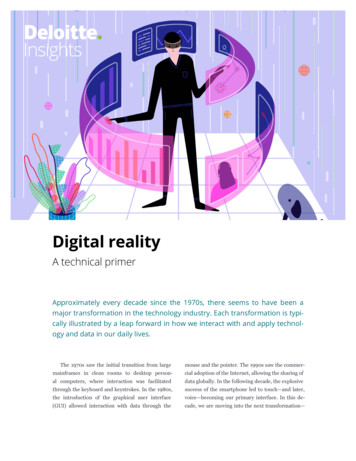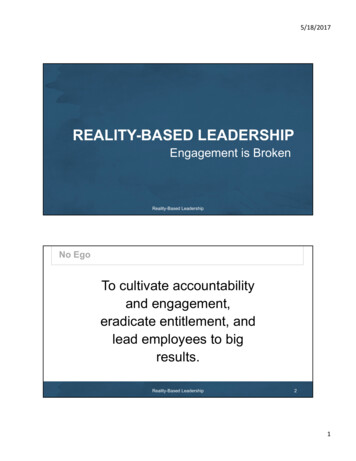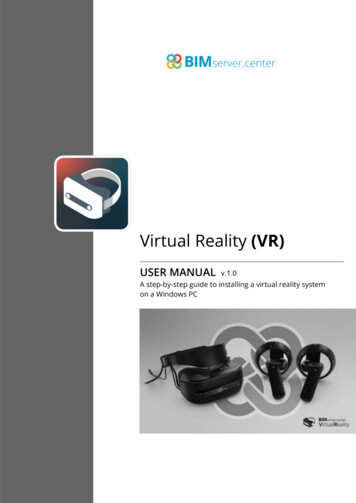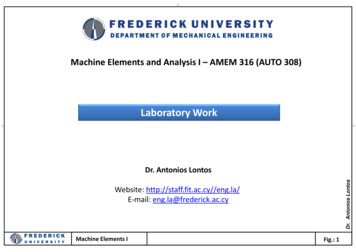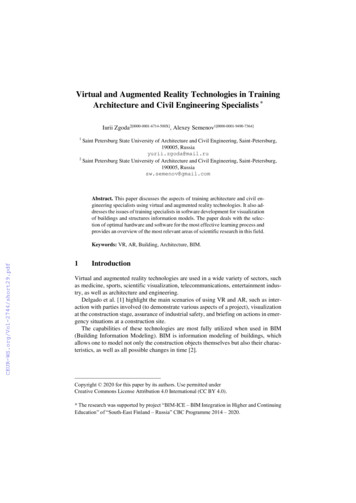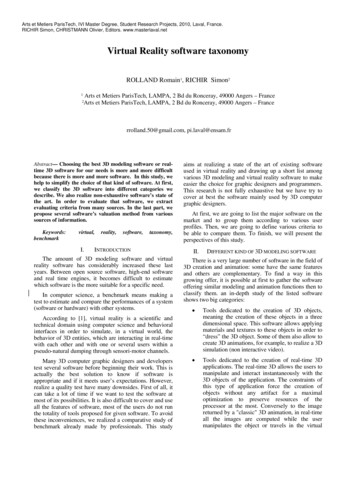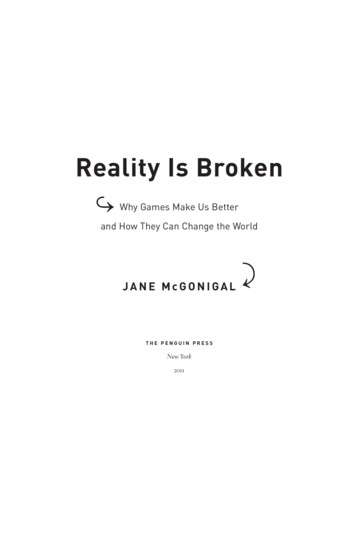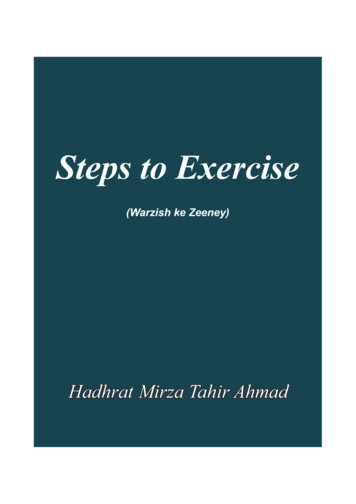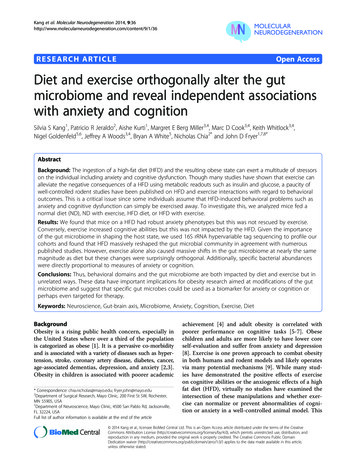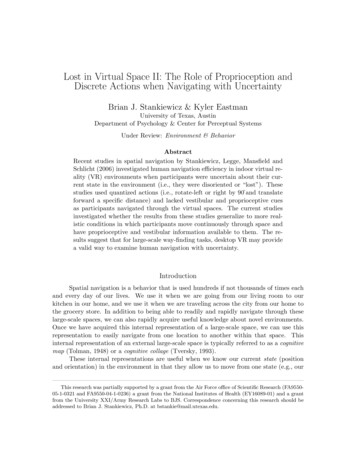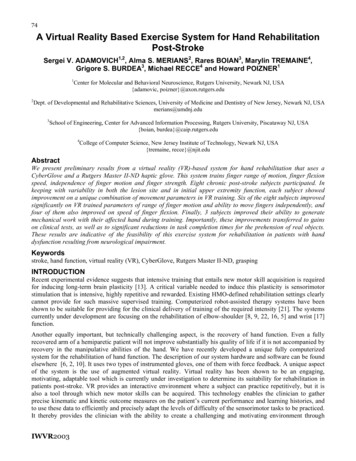
Transcription
74A Virtual Reality Based Exercise System for Hand RehabilitationPost-StrokeSergei V. ADAMOVICH1,2, Alma S. MERIANS2, Rares BOIAN3, Marylin TREMAINE4,Grigore S. BURDEA3, Michael RECCE4 and Howard POIZNER112Center for Molecular and Behavioral Neuroscience, Rutgers University, Newark NJ, USA{adamovic, poizner}@axon.rutgers.eduDept. of Developmental and Rehabilitative Sciences, University of Medicine and Dentistry of New Jersey, Newark NJ, USAmerians@umdnj.edu3School of Engineering, Center for Advanced Information Processing, Rutgers University, Piscataway NJ, USA{boian, burdea}@caip.rutgers.edu4College of Computer Science, New Jersey Institute of Technology, Newark NJ, USA{tremaine, recce}@njit.eduAbstractWe present preliminary results from a virtual reality (VR)-based system for hand rehabilitation that uses aCyberGlove and a Rutgers Master II-ND haptic glove. This system trains finger range of motion, finger flexionspeed, independence of finger motion and finger strength. Eight chronic post-stroke subjects participated. Inkeeping with variability in both the lesion site and in initial upper extremity function, each subject showedimprovement on a unique combination of movement parameters in VR training. Six of the eight subjects improvedsignificantly on VR trained parameters of range of finger motion and ability to move fingers independently, andfour of them also improved on speed of finger flexion. Finally, 3 subjects improved their ability to generatemechanical work with their affected hand during training. Importantly, these improvements transferred to gainson clinical tests, as well as to significant reductions in task completion times for the prehension of real objects.These results are indicative of the feasibility of this exercise system for rehabilitation in patients with handdysfunction resulting from neurological impairment.Keywordsstroke, hand function, virtual reality (VR), CyberGlove, Rutgers Master II-ND, graspingINTRODUCTIONRecent experimental evidence suggests that intensive training that entails new motor skill acquisition is requiredfor inducing long-term brain plasticity [13]. A critical variable needed to induce this plasticity is sensorimotorstimulation that is intensive, highly repetitive and rewarded. Existing HMO-defined rehabilitation settings clearlycannot provide for such massive supervised training. Computerized robot-assisted therapy systems have beenshown to be suitable for providing for the clinical delivery of training of the required intensity [21]. The systemscurrently under development are focusing on the rehabilitation of elbow-shoulder [8, 9, 22, 16, 5] and wrist [17]function.Another equally important, but technically challenging aspect, is the recovery of hand function. Even a fullyrecovered arm of a hemiparetic patient will not improve substantially his quality of life if it is not accompanied byrecovery in the manipulative abilities of the hand. We have recently developed a unique fully computerizedsystem for the rehabilitation of hand function. The description of our system hardware and software can be foundelsewhere [6, 2, 10]. It uses two types of instrumented gloves, one of them with force feedback. A unique aspectof the system is the use of augmented virtual reality. Virtual reality has been shown to be an engaging,motivating, adaptable tool which is currently under investigation to determine its suitability for rehabilitation inpatients post-stroke. VR provides an interactive environment where a subject can practice repetitively, but it isalso a tool through which new motor skills can be acquired. This technology enables the clinician to gatherprecise kinematic and kinetic outcome measures on the patient’s current performance and learning histories, andto use these data to efficiently and precisely adapt the levels of difficulty of the sensorimotor tasks to be practiced.It thereby provides the clinician with the ability to create a challenging and motivating environment throughIWVR2003
75which the needed intensive, repetitive, and rewarded practice of new motor skills can be delivered. Both repetitivepractice and new skill acquisition have been shown to be prerequisites for inducing long-term functionalplasticity. One aim of this study was to show feasibility of the current implementation of the system for retraininghand function in patients in the chronic phase post-stroke.Although recent technological advances including the use of interactive virtual reality environments promise toadvance hand rehabilitation, the transfer process of the skills acquired during the VR-augmented, or VR-basedtherapy to real world movements is poorly understood. Knowledge of how rehabilitation in VR will transfer toeveryday life is very limited. Therefore a second goal of this study was to determine the degree to which the newmotor skills acquired during training of the hemiplegic hand in VR transferred to non-trained natural real-worldarm movements in the patients with chronic hand dysfunction as a result of a stroke. In order to estimate thedegree to which the improvements in the VR exercises might have generalized to the activities of everyday life,we analyzed coordination of the arm and finger joints during reach-to-grasp movements.METHODSSubjectsEight subjects (6 male, 2 female; age range 50-81) were selected to participate in this study. Seven of the subjectssustained a right hemisphere lesion and one had a left hemisphere lesion, all occurring at least one year prior tothe training regimen described here. The subjects were selected according to the following criteria: they were ableto actively extend the wrist of the hemiplegic limb at least 20 and extend the metacarpophalangeal joints at least10 [20]. None of the subjects were receiving therapy at the time of the study.VR TherapyTwo hand input devices were used, a CyberGlove from Immersion Co. and the Rutgers Master II-ND (RMII)force feedback glove prototype developed in the Human-Machine Interface Laboratory at Rutgers University [3].Four hand exercise simulations were developed using the commercially available WorldToolKit graphics library[1]. The exercises were in the form ofsimple games that provided frequentfeedback about the success of the action aswell as the quality of the performance toencourage participation and concentration(see Fig. 1). The subjects receivedauditory, visual and numerical feedbackabout their target goal and their ongoingperformance. First, after each trial“performance meters” on the computerABscreen, both numerical and graphical,indicated the level of success in relation tothe target goal; second the patients alwayshad a view of their virtual hand as well asof their real hand so they receive constantinformation about their performance [2].Each game was designed to exercise oneparameter of finger movement: eitherrange, speed of movement, or fractionation(using the CyberGlove) or strengthening ofCDthe fingers (using the Rutgers Masterglove). An Oracle database transparentlyFigure 1. Screen snapshots for the four VR exercises (A) rangestores all exercise data for later retrievalof motion, (B) speed of movement, (C) finger fractionation andand analysis. All of the patients(D) finger strength (adapted from Boian et al., 2002). Rutgersparticipated in an intensive programUniversity 2001.consisting of 13 days of training and twoIWVR2003
76weekend breaks for a total of nearly 3 weeks of training. One subject (LD) missed two days during the secondweek of the therapy. Each VR exercise session consisted of four training blocks; range of motion, speed ofmovement, fractionation of individual finger motion and strengthening of the fingers. The subjects trained for 2 to2 and one-half hours each day.Generalization TestsWe utilized both clinical tests and kinematic analyses of prehension movements to evaluate the degree of transferof the gains acquired by the subjects in the VR exercises to real life hand movements. Subjects were tested on theJebsen Test of Hand Function [7] which consists of seven subtests that provide a broad sampling of functionaltasks. These consist of writing, turning index cards, picking up small common objects, simulated feeding,stacking checkers, picking up large light objects and picking up large heavy objects. In addition, we analyzed thekinematics of the finger and arm motion during a real-world prehension task. Specifically, we looked at the handand finger kinematics of five-finger precision prehension tasks that involved picking up two small objects (a rollof tape and a rectangular box) from a table. The data were collected before and after VR rehabilitation therapyReal-World Grasping Tests.Data AcquisitionThe 3D coordinates of the arm joints and the trunk were tracked by electromagnetic position sensors (Flock ofBirds, Ascension Technologies Inc.). Finger joint flexion and extension were obtained via resistive bend sensorsembedded in a glove (CyberGlove, Immersion Co.). The flexion/extension of the metacarpophalangial (MCP) andproximal interphalangial (PIP) joints of the five fingers, the abduction/adduction joints of the index-middle andmiddle-ring fingers (ABD), as well as the thumb rotation and abduction were included in the analysis. Bothdevices were connected to a SGI Octane/SSE workstation. All experimental sessions were videotaped for offlineanalysis of error patterns. During the experiment, objects were presented in a pseudo-randomized fashion.Subjects were instructed to maintain the initial position until they heard a tone signaling the start of the trial. Oncethe tone sounded, subjects reached to and grasped the object, lifted the object vertically, and placed it on aplatform. Each subject made a total of 40 reaches per experiment. If the subject did not grasp an objectsuccessfully (e.g., he was not able to lift the object and release it on the platform), another trial was run in itsplace. Subjects practiced before the experiment for 5 to 10 trials. One subject (LD) was not able to grasp theobjects, and had to use smaller objects of the same shape, both before and after the therapy. Interestingly, after thetherapy he was able to grasp and lift regular size objects (these movements are not analyzed here).Data AnalysisWrist trajectories were inspected visually using a system for 3D graphic analysis of human movements thatpermits the precise localization of movement onsets and offsets as a function of speed and acceleration [14, 15].Onset and offset were defined as the points in which the wrist sensor reached 5% of the peak velocity during theinitial acceleration phase and during the acceleration phase of the lifting phase of the movement, respectively. Weanalyzed the following parameters of the hand motion: peak velocity and movement time (MT). We divided MTinto two sections: onset – time of peak velocity and time of peak velocity to time of object lifting.Multivariate statistical analysisAll trial data were normalized in time. Subsequent analyses were conducted on 5% epochs of the movement, from5 to 95%. Data matrices containing the angle of flexion/extension or abduction/adduction for each joint for eachtrial for grasps of each object at each time interval were produced for input to the statistical analysis. Twodifferent types of discriminant analysis were used: Stepwise Discriminant Analysis (SDA) and CanonicalDiscriminant Analysis (CDA). The former (SAS STEPDISC) is a forward stepwise procedure which selectsdiscriminating variables by establishing a statistical criterion (Wilk’s Lambda). CDA produces a classification ofthe data into a set of previously determined categories by defining a centroid per category and calculating thedistance [11] between each data point and each of the centroids. A data point was included by CDA into thecategory whose centroid is closest. A measurement of error, therefore, becomes available when data points areclassified into the wrong groups (misclassifications).IWVR2003
77RESULTSProgress in VRFigure 2 shows for one subject therelationship between the performancein each VR exercise and number ofdays of training. Subject EM showedimprovement on each of the fourparameters: range, speed, fractionationand power, except for the thumb speed.Overall, 6 out of 8 subjects increasedsignificantly their finger and thumbrange of motion (p .05, unpaired t-test,averaged across all fingers, the firsttwo days versus the last two days ofthe therapy, see Fig. 3). Similarly, 4subjects improved significantly infinger speed and 2 in thumb speed, 7 infractionation and 3 in strength exercise.Gains in finger strength were modest,due in part to low levels of forcefeedback in the Rutgers Master glove,Figure 2. The regression analysis of the performance in each VRwhich in turn was due to an unexpectedexercise for subject EM.hardware malfunction during thetherapy for the first four subjects. Patients showed good retention when measured at one-week post intervention.Figure 3. Percentage increase between the first two days and the last two days of the therapy forfour exercises: range of motion, flexion speed, fractionation and mechanical power. Significantincreases are marked by asterisks.IWVR2003
78Figure 4. Jebsen Test of Hand Function scoresbefore and after the three-week VR therapyaveraged across 8 subjects. Lower scores indicatebetter performance.Generalization TestsTo determine whether the skills gained in the VR environment transferred to real-world movements, we utilizedclinical tests and kinematic analysis of prehension movements. Clinical evaluation using the Jebsen Test of HandFunction showed a reduction in task completion time for the affected hand after the therapy (paired t-test, t 2.4,p .05, see Fig. 4). In contrast, no changes were observed for the unaffected hand (t .59, p .54).Furthermore, we studied finger and hand kinematics during reach-to-grasp movement. When tested before thebeginning of the therapy, each subject showed various severe deficits in both the transport component (slowness,excessive trunk involvement, elbow-shoulder discoordination) and the grasping component (abnormal fingerflexion-extension patterns, increased variability and desynchronization between the hand and finger motion).After the therapy, subjects showed some improvement in various aspects of the hand kinematics during grasping.Neither time to peak velocity nor peak velocity of the affected handchanged after the therapy (F(1,7) .55, p .48 and F(1,7) .97, p .35.This result could be expected since elbow and shoulder were nottrained during the VR therapy. In contrast, time from hand peakvelocity to the moment when the object was lifted from the tabledecreased significantly after the therapy (F(1,7) 5.78, p .04). Onaverage, the task was performed 22% faster after the interventionillustrating transfer of their improvement in the VR to a real-worldfunctional task (Fig. 5). This was achieved through improved patternsof finger coordination. In particular, subject FAB showed the largestdecrease in the duration of grasping. She had a severedesynchronization of the arm and finger degrees of freedom beforethe therapy and showed a substantial increase in the temporal stabilityof finger motion after the therapy. 3 subjects did not perform thistask faster after the therapy (improvement under 10%). Nevertheless,each of these subjects improved on at least one of the aspects ofprehension kinematics. In particular, subject RB with an abnormalFigure 5. Overall mean (SE) time tofinger flexion–extension synergy significantly reduced finger inter–peak hand velocity and time from peaktrial variability after the therapy. Subject AG showed improvedvelocity to movement offset for thepatterns of hand preshaping (see below). Subject FAB, the leasthemiparetic arm tested before (darkerbars) and after the therapy.IWVR2003
79affected in the group improved on grasping of objects of morecomplex shapes.Figure 6 shows the kinematics of a reach-to-grasp movement foranother subject with severely reduced range of finger motion due tospasticity in the index and middle fingers. Mean finger angles, handroll angle and hand position are shown over time before and afterthe therapy. Dotted lines indicate standard deviations about themean. The subject showed a modest post-therapy decrease inmovement duration. Note, however, a substantial post-therapyincrease in the range of motion for the two spastic fingers (Fig. 6,two upper rows of panels, compare to Fig. 2, left upper panel). Weused a sophisticated method of analyzing finger coordination duringgrasping objects of various sizes and shapes by means of lineardiscriminant analysis [18, 19]; see Methods). One example of thisanalysis for the subject EM is shown in Fig. 7. Handshapeclassification errors pooled over trials for picking up a roll of tapeand picking up a small rectangular object are presented over thecourse of the movements. The level of discrimination error reflectsthe degree to which the hand is preshaping as the movementevolves. Note that the late decrease in error levels for the unaffectedarm is an artifact of time normalization, since movements of theunaffected arm were 3 times shorter than movements of the affectedarm. The subject showed only a moderate decrease in the durationFigure 6. Mean (SD) time traces of 10of the postfinger angles (deg), hand coordinatestherapy(cm), and arm pronation/supinationmovementsofangle (deg) during a prehensiontheaffectedmovement for subject EM. Averages ofarm (see Fig.10 trials before (thick lines) and after(thin lines) the therapy are shown.6). However,thediscriminantanalysis clearlyshows a marked improvement in the subject’s ability tocontrol his fingers – late into the movement the level ofclassification error reaches normal levels.Figure 7. Patterns of handshape classificationerrors during a reach-to-grasp movement forsubject EM.DISCUSSIONIn this preliminary study we demonstrated the feasibility of our recently developed exercise system for handrehabilitation in patients with hand dysfunction resulting from neurological impairment. Several systems havebeen developed by other research groups to retrain upper extremity function in patients post-stroke. However, nosystem has been developed to re-train hand coordination and dexterity. The ability of patients to utilize theirhands effectively for everyday tasks is extremely important to improving the quality of life and level ofindependence post-stroke. To our knowledge, this is the first fully integrated, computerized system to train handIWVR2003
80function. The system includes VR-based interfaces, objective evaluation of finger motion through the use ofinstrumented gloves, online adaptation of exercise targets to the current status of the patient, and storage/retrievalof the data in an online database. This is a unique VR-based rehabilitation system that allows for objectivemeasures of the current status of subject’s hand function, as well as progress during the therapy. We tested thissystem on 8 hemiparetic subjects. Six of the eight subjects improved in both the VR measures and the clinicaltests. In keeping with clinical outcomes of patients that have variability in both the lesion site and in initial upperextremity function, each subject showed improvement on a unique constellation of movement parameters (rangeof motion, speed, fractionation and strength) and clinical tests (Jebsen test). The patients with more severeimpairments did not recover as much function as those with greater abilities. We have noticed this trendpreviously [10]. It is interesting to speculate whether this might be due to the particular lesion location or the needfor a greater variety of VR games that could more directly target the lower impairment levels.We believe that functional plasticity will likely underline many of the effects that we are getting in VR-basedrehabilitation. Recent animal studies demonstrated the importance of motor learning versus unskilled repetitivemovements in producing changes in motor maps. It has recently been shown that in addition to the importance ofrepetition in inducing synaptic reorganization it is critical that the repetitive motor activity involves the learningof a motor skill [13]. It has been demonstrated in animal studies that only repetitive training in a sufficientlychallenging environment (retrieval of food pellets by the monkey from a small versus wide well [13] drivesrepresentational plasticity and perhaps engenders improved motor control [12]. It is clear from these studies thatrehabilitation paradigms must be based upon our understanding that the nervous system has the potential forneural modification and that attention, repetition, reward, progression of complexity and skill acquisition arecritical conditions of practice for driving this change in neural structure and function. Results obtained in thisfeasibility study indicate that VR has the potential to serve as an appropriate environmental tool to apply theseconditions of practice.In terms of patients with neurological impairment, it has not been well elucidated whether skills acquired throughpractice in a VR environment transfer to real-world activities. One of the outcome measures used in this study totest generalizability of the VR practice was the Jebsen Test of Hand [7]. An important finding was that there wasa significant improvement in the time scores of this functional clinical measure as a result of the VR training,indicating that the changes evident in the VR measures appeared to transfer to real-world function. Moreover, thisgeneralization was also evident in several of the kinematic measures of grasping. In particular, we observed onaverage a reduction in time needed to pick up objects of simple shapes from a table. The decrease resultedexclusively from the reduction in the deceleration phase of the movement indicating the improvement occurred inthe grasping component but not in the transport component of the movement. Subjects with abnormal fingerflexion–extension synergies or abnormal desynchronization of the finger motion reduced the inter-trial variabilityafter the therapy. Moreover, subjects with severe spasticity increased the range of finger motion. This in turnresulted in the improved preshaping of the hand during reaching for objects of different shapes (see [19]).The combination of VR with a computerized therapy system can provide new tools for creating treatments, byextending the role of the therapist in the clinic. Desktop VR has significantly less side effects (e.g. dizziness) seenin the fully-immersive VR environments using head-mounted displays It provides precise kinematic and kineticdata on subjects' baseline performance and learning history and updating of motor task difficulty affording greatprecision in individualizing treatment programs. This combination constantly challenges patients to learn newmotor skills. The usability of this computerized environment will further increase in the near future when the“MTV generation” will become, in part, the target population of these video game-based therapies. Finally, fullycomputerized systems will make telerehabilitation possible in the future, with potential cost savings and increasedpatient access [4].ACKNOWLEDGEMENTSThis study was supported in part by a grant from the New Jersey Commission on Science and Technology, and byNIH grants NS 36449 and HD 42161. The authors wish to thank Anu Arora, Jeffrey A. Lewis and Gene Tunik fortheir technical assistance.IWVR2003
81REFERENCES[1] Engineering Animation Inc., WorldToolKit, www.eai.com/products/sense8 /worldtoolkit.html, 2000.[2] Boian, R, Sharma, A, Han, C, Merians, AS, Burdea, G, Adamovich, S, Recce, M, Tremaine, M and Poizner, H. Virtualreality-based post stroke rehabilitation. Proceedings of MMVR2002 Conference, Newport Beach, CA, pp. 64-70, 2002.[3] Bouzit, M, Burdea, G, Popescu, V, and Boian, R, “The Rutgers Master Force Feedback Glove,” IEEE/ASMETransactions on Mechatronics, vol. 7, pp. 256-263, June 2002.[4] Burdea, G, “Keynote Address: Virtual Rehabilitation-Benefits and Challenges,” 1st International Workshop on VirtualReality Rehabilitation (Mental Health, Neurological, Physical, Vocational) VRMHR 2002 Lausanne, Switzerland,November 7-8, pp. 1-11, 2002. Reprinted in the 2003 International Medical Informatics Association Yearbook ofMedical Informatics, Heidelberg, Germany, pp. 170-76.[5] Burgar, CG, Lum, PS, Shor, PC, Machiel, Van der Loos, HF. Development of robots for rehabilitation therapy: the PaloAlto VA/Stanford experience. J. Rehabil. Res. Dev., vol. 37, pp. 663-673, 2000.[6] Jack, D, Boian, R, Merians, A, Tremaine, M, Burdea, GC, Adamovich, SV, Recce, M, and Poizner, H. Virtual RealityBased Stroke Rehabilitation. IEEE Trans. Neural Syst. Rehabil. Eng., vol. 9, pp. 308-318, 2001.[7] Jebsen, RH, Taylor, N., Trieschmann, RB, Trotter, MJ and Howard, LA An objective and standardized test of handfunction. Arch. Phys. Med. Rehabil., pp. 311-319, 1969.[8] Krebs, HI, Hogan, N, Aisen, ML, Volpe, BT. Robot-aided neurorehabilitation. IEEE Trans. Rehabil. Eng., vol. 6, pp. 7587, 1998.[9] Krebs, HI, Volpe, B, Aisen, M, Hening, W, Adamovich, S, Poizner, H, Subrahmanyan, K, Hogan, N. RoboticApplications in Neuromotor Rehabilitation. Robotica, vol. 21, pp. 3-11, 2003.[10] Merians, A., Jack, D., Boian, R., Tremaine, M., Burdea, G.C., Adamovich, S.V., Recce, M., and Poizner, H. Virtualreality-augmented rehabilitation for patients following stroke. Phys. Therapy, vol. 82, pp. 898-915, 2002.[11] Mahalanobis, PC On the generalised distance in statistics. Proceedings of the Indian National Institute of Science, vol. 2,pp. 49-55, 1936.[12] Nudo, RJ, Plautz, EJ and Frost, SB Role of adaptive plasticity in recovery of function after damage to motor cortex.Muscle Nerve, vol. 24, pp. 1000-1019, 2001.[13] Plautz, EJ, Milliken, G. W., & Nudo, R J. Effects of repetitive motor training on movement representations in adultsquirrel monkeys: role of use versus learning. Neurobiol. Learn. Mem., vol. 74, pp. 27-55, 2000.[14] Poizner, H., Mack, L., Verfaellie, M., Rothi, L J, and Heilman, K. M. Three-dimensional computerographic analysis ofapraxia. Neural representations of learned movement. Brain, vol. 113, pp. 85-101, 1990.[15] Poizner, H., Wooten, E., and Salot, D. Computergraphic Modeling and Analysis: A Portable System for Tracking ArmMovements in Three-Dimensional Space. Behavior Research Methods, Instruments, and Computers: Special Issue onComputers and Vision, vol. 18, pp. 427-433, 1986.[16] Reinkensmeyer, DJ, Kahn, LE, Averbuch, M, McKenna-Cole, A, Schmit, BD, Rymer, WZ. Understanding and treatingarm movement impairment after chronic brain injury: progress with the ARM guide. J. Rehabil. Res. Dev., vol. 3, pp.653-662, 2000.[17] Reinkensmeyer, DJ, Pang, CT, Nessler, JA, Painter, CC. Web-based telerehabilitation for the upper extremity afterstroke. IEEE Trans. Neural Syst. Rehabil. Eng., vol. 10, pp. 102-108, 2002.[18] Santello, M, & Soechting, JF Gradual molding of the hand to object contours. J. Neurophysiol, vol. 79, pp. 1307-1320,1998.[19] Schettino, LF, Adamovich, SV and Poizner, H. The role of visual feedback in the determination of hand coordinationduring grasping. Exp. Brain Res., vol. 151, pp. 158-66, 2003.[20] Taub, E, Wolf, SL. Constraint induced movement techniques to facilitate upper extremity use in stroke patients. TopStrokeRehabil.,vol.3,pp.38-61,1997.[21] Volpe, BT, Krebs, HI, Hogan, N. Is robot-aided sensorimotor training in stroke rehabilitation a realistic option?Curr. Opin. Neurol., vol. 14, pp. 745-752, 2001.[22] Volpe, BT, Krebs, HI, Hogan, N, Edelstein, OTR L, Diels, C, Aisen, M. A novel approach to stroke rehabilitation:robot-aided sensorimotor stimulation. Neurology, vol. 54, pp. 1938-1944, 2000.IWVR2003
IWVR2003 74 A Virtual Reality Based Exercise System for Hand Rehabilitation Post-Stroke Sergei V. ADAMOVICH1,2, Alma S. MERIANS2, Rares BOIAN3, Marylin TREMAINE4, Grigore S. BURDEA3, Michael RECCE4 and Howard POIZNER1 1Center for Molecular and Behavioral Neuroscience, Rutgers University, Newark NJ, USA {adamovic, poizner}@axon.rutgers.edu

